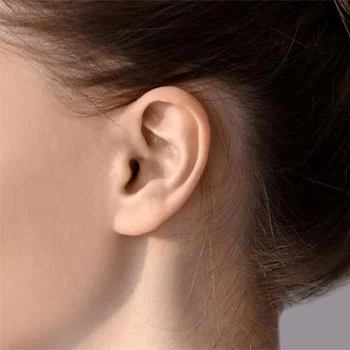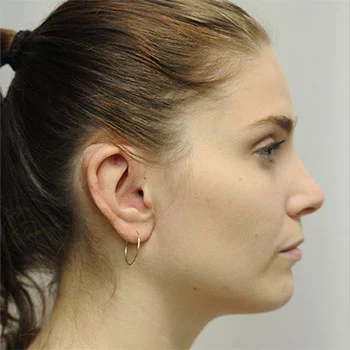What is cryptotia?
Cryptotia, also known as hidden ear deformity or buried ear, is a congenital condition characterized by an abnormal positioning of the external ear. In individuals with cryptotia, the upper part of the ear, known as the helix, is partially or completely hidden beneath the skin of the scalp. This results in the ear appearing flattened and fused with the side of the head.
The exact cause of cryptotia is not fully understood, but it is believed to be primarily due to abnormal development of the cartilage and soft tissues during fetal growth. It is often present at birth and can affect one or both ears. Cryptotia is more commonly seen in individuals of Asian descent, although it can occur in people of any ethnicity.
The condition itself is generally harmless and does not cause any functional problems. However, it can have significant psychological and aesthetic impacts on the affected individual, leading to self-consciousness and social difficulties, particularly during childhood and adolescence.
What is cryptotia surgery?
Cryptotia surgery, also known as buried ear correction surgery, is a procedure performed to correct the congenital condition known as cryptotia or hidden ear deformity. The goal of the surgery is to reposition the buried ear to a more normal and prominent position, improving its appearance and restoring a natural contour.
Treatment for cryptotia typically involves surgical correction, which aims to reposition the buried ear to a more normal position. The surgery is usually performed when the child is around 5 to 7 years old, as this is the age when the ear has grown sufficiently to allow for the procedure. The surgical technique may vary depending on the severity of the deformity, but it generally involves releasing the buried ear from the scalp, reshaping the cartilage, and securing the ear in a more prominent position.
When is the Right Time For Cryptotia Correction Surgery?
The optimal timing for cryptotia surgery depends on various factors, including the age of the patient and the severity of the condition. In general, cryptotia surgery is typically performed when the child is around 5 to 7 years old. This is because by this age, the ear has grown sufficiently to allow for the surgical correction.
Performing the surgery at this age has several advantages. The cartilage of the ear is more malleable and easier to shape, allowing for better surgical outcomes. Additionally, the child is typically more cooperative and able to follow postoperative care instructions, such as wearing protective headbands or avoiding activities that may disrupt the healing process.
However, the timing of the surgery may vary depending on individual cases. In some instances, surgery may be performed earlier if the condition is severe or if there are functional concerns related to hearing or ear development. Conversely, if the deformity is mild and does not cause significant distress, the surgery may be delayed until the child is older and can actively participate in the decision-making process.
It is crucial to consult with a qualified plastic surgeon or an otolaryngologist who specializes in cryptotia surgery to determine the most appropriate timing for the surgery in your specific case. They will evaluate the severity of the deformity, consider the child's age and development, and provide guidance on the optimal timing for the procedure. Regular follow-up visits with the surgeon will also help monitor the progress of the condition and determine the appropriate timing for intervention if necessary.
Can Adults Have Cryptotia Surgery?
While the optimal time for surgery is typically during childhood, it doesn't mean that adults with cryptotia cannot undergo corrective surgery.
The decision to pursue surgery in adulthood depends on various factors, including the individual's specific case, their personal goals and motivations, and the expertise and recommendations of the plastic surgeon or otolaryngologist. Adults may choose to have the surgery for cosmetic reasons, to improve self-esteem and confidence, or to address functional concerns related to hearing or ear development.
However, it's important to note that the success of cryptotia surgery in adulthood may be influenced by certain factors. The cartilage of the ear becomes less pliable and more rigid with age, making surgical reshaping more challenging. Scar tissue from previous surgeries or trauma may also affect surgical outcomes. Additionally, recovery and healing may take longer in adults compared to children.
During a consultation with a qualified plastic surgeon or otolaryngologist, they will assess the individual's specific case, evaluate the severity of the deformity, and discuss the potential risks, benefits, and expected outcomes of the surgery. They will provide personalized recommendations based on the individual's goals and circumstances, taking into account the feasibility and potential challenges of the procedure in adulthood.
It's important to have realistic expectations and understand that the results of cryptotia surgery in adulthood may differ from those achieved in childhood. Consulting with a skilled and experienced surgeon will help determine the most appropriate course of action for achieving the desired outcome.
How to Prepare My Child For Cryptotia Surgery?
Preparing your child for buried ear correction surgery involves a combination of practical and emotional preparation. Here are some steps you can take to help your child feel more comfortable and prepared for the surgical procedure:
- Open and honest communication: Talk to your child about the upcoming surgery in a calm and reassuring manner. Use age-appropriate language to explain why the surgery is necessary and what they can expect during and after the procedure. Encourage them to ask questions and address any concerns they may have.
- Choose an appropriate time: Consider the timing of the surgery and choose a time when your child is not dealing with other stressful events, such as starting a new school year or going through personal challenges. This can help minimize additional stress and distractions.
- Provide information and visuals: Use educational resources, books, or videos specifically designed for children to explain the surgery. These resources can help your child understand the process and visualize what will happen. It can also be helpful to show them before and after photos of other children who have undergone the same procedure.
- Involve your child in decision-making: Depending on their age, involve your child in decision-making when appropriate. For example, they may have a choice in selecting the color or design of the headband or bandage they will wear post-surgery. This can give them a sense of control and involvement in their own care.
- Meet the surgical team: If possible, arrange for your child to meet the surgical team before the procedure. This can help alleviate anxiety by familiarizing them with the healthcare professionals who will be taking care of them.
- Follow preoperative instructions: Ensure that you follow any preoperative instructions provided by the surgical team, such as fasting requirements or medication restrictions. This will help ensure a smooth and safe surgical experience.
- Emotional support: Provide emotional support to your child throughout the process. Reassure them that you will be there with them during the surgery and the recovery period. Encourage them to express their feelings and be empathetic to their concerns.
Remember that every child is unique, and their response to surgery preparation may vary. Tailor your approach based on your child's age, personality, and individual needs. If needed, consult with the surgical team for additional guidance on preparing your child for cryptotia surgery.
What to Expect Before Cryptotia Surgery?
Before cryptotia surgery, you can expect several steps to ensure that you and your child are prepared for the procedure. Here's an overview of what to expect:
- Initial consultation: You will have an initial consultation with a qualified plastic surgeon or an otolaryngologist who specializes in cryptotia surgery. During this consultation, the surgeon will evaluate the patient’s specific case, discuss the surgical options, and address any questions or concerns you may have. They will also explain the expected outcomes, potential risks, and provide instructions for preoperative preparations.
- Preoperative evaluations: The patient may need to undergo certain preoperative evaluations to ensure they are in good health for surgery. These evaluations may include a general physical examination, blood tests, and potentially imaging studies like X-rays or CT scans to assess the anatomy of the ear.
- Medical history and consent forms: You will need to provide a detailed medical history of the patient, including any previous surgeries, allergies, or medical conditions. You will also be required to sign consent forms, indicating your understanding and agreement to proceed with the surgery.
- Preoperative instructions: Your surgeon will provide specific instructions to prepare the patient for the surgery. These may include guidelines on fasting (avoiding food and liquids for a certain period before the surgery), discontinuing certain medications, and ensuring proper hygiene before the procedure. It's important to follow these instructions carefully to minimize any potential risks.
- Anesthesia consultation: If the patient will be undergoing general anesthesia during the surgery, you may have a separate consultation with an anesthesiologist. They will evaluate the patient’s medical history, discuss the anesthesia plan, and address any concerns or questions you may have regarding anesthesia.
- Preparing for the hospital or surgical facility: Ensure that you have all the necessary arrangements in place for the day of the surgery. This may include arranging transportation to and from the hospital or surgical facility, ensuring you have any required documents or identification, and packing any essentials the patient may need during their stay.
How is Cryptotia Surgery Performed?
The specific surgical technique used in cryptotia surgery can vary depending on the severity of the deformity and the individual patient's needs. However, the general steps involved in the procedure are as follows:
- Anesthesia: The surgery is typically performed under general anesthesia, ensuring that the patient is asleep and pain-free throughout the procedure.
- Incision: The surgeon makes an incision behind the ear, in the natural crease where the ear meets the scalp. This location helps conceal any resulting scars.
- Release of the buried ear: The surgeon carefully releases the buried ear from the surrounding scalp tissues, allowing it to be brought forward and repositioned.
- Cartilage reshaping: In cases where the cartilage of the buried ear is malformed or misshapen, the surgeon may reshape it to create a more natural appearance. This may involve techniques such as scoring, suturing, or cartilage grafting.
- Fixation: Once the ear has been repositioned and reshaped, the surgeon uses internal sutures and sometimes external splints or dressings to hold the ear in its new position. This helps maintain the desired shape and prevents any unwanted movement during the healing process.
- Closure: The incisions are carefully closed with sutures, and the surgical site is dressed with sterile bandages.
Following the surgery, the patient will be monitored in a recovery area until they wake up from anesthesia. Pain medication and antibiotics may be prescribed to manage discomfort and prevent infection.
What to Expect For the Recovery Period?
The recovery process after cryptotia surgery can vary from person to person, but here are some general aspects to consider:
- Pain and discomfort: Mild to moderate pain and discomfort are common after cryptotia surgery. Your surgeon will prescribe pain medications to help manage any discomfort during the initial days or weeks following the surgery.
- Swelling and bruising: Swelling and bruising around the surgical site are normal. They usually peak within the first few days and gradually subside over the following weeks. Applying cold compresses and keeping the head elevated can help minimize swelling.
- Dressings and bandages: Your surgeon will provide specific instructions on how to care for the surgical site. This may involve keeping the area clean and dry, changing dressings, or wearing a protective headband or bandage to support the healing process and maintain the new position of the ear.
- Activity restrictions: It's important to avoid activities that can put a strain on the surgical area during the initial recovery period. Your surgeon will provide guidelines on when it is safe to resume normal activities, including sports or physical exercise.
- Follow-up visits: Regular follow-up visits with your surgeon are crucial to monitor the healing progress and ensure that the desired results are being achieved. During these visits, your surgeon may remove sutures, assess the healing process, and provide further instructions for postoperative care.
- Duration of recovery: The recovery period can vary depending on the individual and the specific surgical technique used. In general, it may take several weeks for the initial swelling and bruising to subside. However, complete healing and resolution of all postoperative symptoms can take several months.
It's important to closely follow your surgeon's instructions for postoperative care, including any specific wound care, medication usage, and activity restrictions. By doing so, you can help optimize the healing process and ensure the best possible outcome.
During the recovery period, it's normal to have questions or concerns. If you experience any unusual or concerning symptoms, such as excessive pain, severe bleeding, or signs of infection, it is important to contact your surgeon promptly for guidance.
What Are the Risks of Cryptotia Surgery?
Like any surgical procedure, cryptotia surgery carries certain risks and potential complications. While the majority of cases proceed without any major complications, it is essential to be aware of the possible risks involved. Some potential risks include:
- Bleeding: Excessive bleeding during or after surgery is a possible risk. However, this risk is minimized through careful surgical techniques and proper hemostasis (control of bleeding) during the procedure.
- Infection: Infections can occur following any surgical procedure. Precautions such as sterile techniques and postoperative antibiotics help reduce the risk. If an infection does occur, it can usually be treated with appropriate antibiotics.
- Scarring: Cryptotia surgery involves incisions, which may result in visible scars. However, the incisions are typically placed in the natural creases behind the ear to help conceal the scars. Most scars fade over time and become less noticeable.
- Asymmetry or unsatisfactory aesthetic outcome: Despite the surgeon's best efforts, achieving perfect symmetry may not always be possible. The final aesthetic outcome can vary between individuals. It's important to have realistic expectations and open communication with your surgeon about your desired outcome.
- Cartilage deformities or irregularities: Reshaping the cartilage during surgery carries a risk of cartilage deformities or irregularities. Surgeons use their expertise and techniques to minimize these risks, but there can be variations in results.
- Anesthesia risks: Anesthesia carries its own set of risks, including allergic reactions, respiratory issues, or adverse reactions to medications. However, these risks are generally low, especially when performed by experienced anesthesiologists and with appropriate preoperative evaluations.
- Numbness or altered sensation: There is a possibility of temporary or permanent numbness or altered sensation in and around the surgical site. However, this risk is relatively low and typically resolves over time.
It's important to note that the risks associated with cryptotia surgery are generally low, and the majority of patients have successful outcomes. Surgeons take precautions to minimize risks and complications, and postoperative care and follow-up visits are crucial for monitoring healing and addressing any concerns.
Prior to the surgery, your surgeon will discuss these risks with you and provide personalized information based on your specific case. It's important to have open communication, ask questions, and follow your surgeon's instructions for preoperative and postoperative care to minimize complications and promote optimal healing.
Cryptotia Surgery Cost
The cost of cryptotia surgery can vary depending on various factors, including the geographical location, the expertise of the surgeon, the complexity of the case, and the specific surgical techniques employed. Additionally, other factors such as hospital or surgical facility fees, anesthesia fees, preoperative evaluations, postoperative care, and any necessary follow-up visits may also contribute to the overall cost.
It is important to consult with a qualified plastic surgeon or an otolaryngologist experienced in cryptotia surgery to obtain an accurate cost estimate specific to your case. They will evaluate the severity of the condition and provide a detailed breakdown of the potential costs involved.
In general, cryptotia surgery can range in price from a few thousand dollars to several thousand dollars. This estimate typically covers the surgeon's fees, facility fees, and anesthesia fees. However, it is important to note that health insurance coverage varies, and some insurance plans may cover a portion of the cost if the surgery is deemed medically necessary. It is advisable to check with your insurance provider to determine the extent of coverage for cryptotia surgery.
It is crucial not to make cost the sole determining factor when choosing a surgeon. Prioritize finding a qualified and experienced surgeon who specializes in cryptotia surgery and has a proven track record of successful outcomes. The expertise and skill of the surgeon are critical for achieving optimal results and minimizing potential risks and complications.




